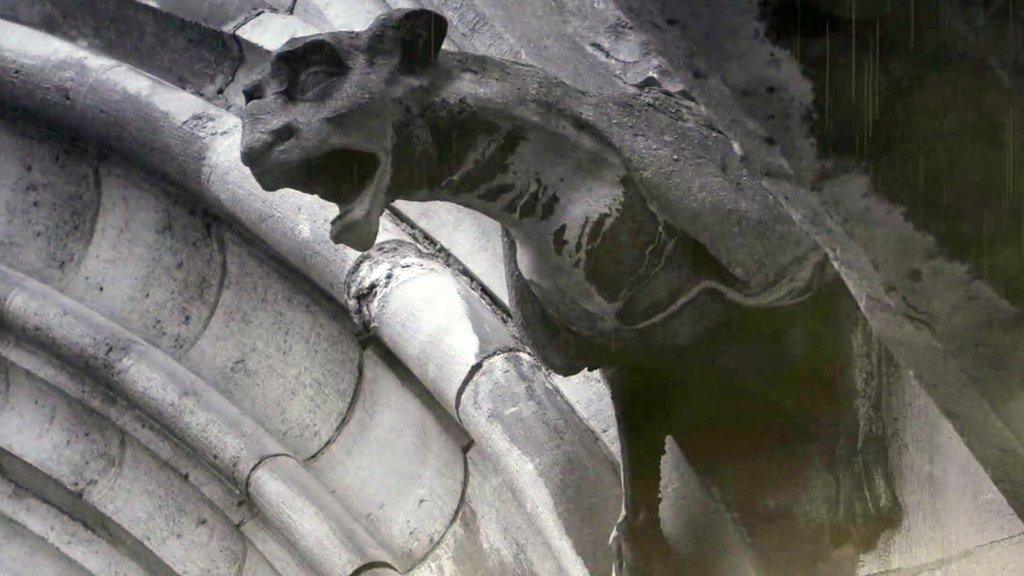Notre-Dame fire: Cathedral saved within crucial half hour
- Published
A look inside fire-ravaged Notre-Dame cathedral
Saving France's 850-year-old Notre-Dame cathedral came down to a crucial time window of 15-30 minutes, France's deputy interior minister has said.
Laurent Nuñez praised the "courage and determination" of firefighters who "risked their own lives" to salvage the building's stone structure and its two towers.
The fire ravaged the cathedral's roof and caused its spire to collapse.
French President Emmanuel Macron has vowed to rebuild it within five years.
The cause of the blaze is unclear.
"We now know it all came down to 15-30 minutes," Mr Nuñez said, adding that police and fire services would spend the next 48 hours assessing the security and safety of the structure.
Paris public prosecutor Rémy Heitz said his office was "favouring the theory of an accident", but had assigned 50 people to investigate the origin of the fire.

The cathedral's spire, before, during the fire and after
Other officials have suggested it could be linked to extensive renovation works taking place at the cathedral.
Thoughts are now turning to how Notre-Dame will be rebuilt, which Mr Macron promised to make "even more beautiful".
"We will turn this catastrophe into an opportunity to come together", he said.
In a televised public address, Mr Macron also heaped praise on the fire services.
"The firefighters stopped the fire by taking the most extreme risks. They were 20 or 25, from each corner of France, from each region."
Hundreds gathered at a vigil for Notre-Dame
A number of companies and business tycoons have so far pledged about €800m ($902m; £692m) between them to help with reconstruction efforts, AFP reports.
Offers of help have also poured in from around the globe, with European Council President Donald Tusk calling on EU member states to rally round.
Eric Fischer, head of the foundation in charge of restoring the 1,000-year-old Strasbourg cathedral, told AFP the Notre-Dame may take "decades" to rebuild.
What happened?
The blaze was discovered at 18:43 local time (16:43 GMT) on Monday, and firefighters were called. The flames quickly reached the roof of the cathedral, destroying the wooden interior before toppling the spire.
Fears grew that the cathedral's famous towers would also be destroyed.
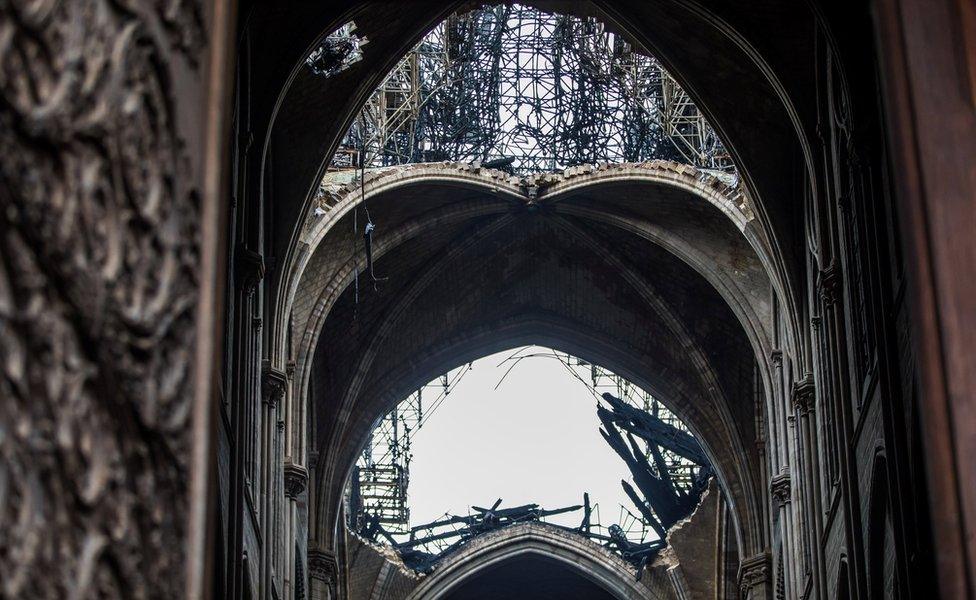
The whole of the roof was "devastated", according to the fire service
But while a number of fires did begin in the towers, Mr Nuñez said they were successfully stopped before they could spread.
The Paris fire service said it was fully extinguished by 10:00 local time (08:00 GMT).
What is the damage?
Search teams had already begun assessing the extent of the damage when dawn broke over the French capital.
The cathedral's blackened stone and charred scaffolding were revealed to onlookers for the first time.

More on the Notre Dame fire:

Photos appear to show that at least one of the cathedral's famed rose windows has survived, although there are concerns for some of the other stained-glass windows.
Christophe Castaner, France's interior minister, warned that while the principal structure had been saved, the building was still unstable.
"We will be standing at [Notre Dame's] bedside", he added.

Mr Nuñez said that "overall", the structure was in good condition, but that "some vulnerabilities" had been identified in the stone vaults and the remainder of the building's ceiling.
Experts have not yet been allowed on site to assess the damage and French firefighters have sent a drone to survey the scale of the destruction.
Heat and water damage will also need to be assessed.
The cathedral's 18th Century organ has not been burned, but it is not clear whether it has been damaged by water, Bertrand de Feydeau, from the French charity Fondation du Patrimoine, told Associated Press.

Praying for the cathedral
By Patrick Jackson, BBC News, Paris
They sit or stand in a crowd, many of them young people, spilling over the end of the Boulevard Saint Michel, this first evening after the fire, singing hymns. On a table beneath the towering sculpture of Saint Michael stands a statue of Our Lady - Notre Dame.
"As a French Catholic," says Éloi, 22, "I felt really bad after the fire so I see this vigil as a way to say that even if the flames destroyed the cathedral, we can rebuild it because the Church is made not of stones but is a living body." He believes the cathedral should be remade just the way it was, as a "prayer to God".
"We are Catholics," he adds, "but all French people - Catholics, Muslims, atheists - are united around this disaster and in the hope it will be rebuilt."
And they are united in pride in the fire brigade. During the concert, an engine hurtles past on the road, and the singing stops as the crowd claps and cheers.

What happens next?
Individuals and groups are mobilising to help rebuild Notre-Dame. Hundreds of millions of euros have already been pledged.
Air France said in a statement that the company would offer free flights to anyone involved in the reconstruction.
Billionaire François-Henri Pinault, chairman and CEO of the Kering group that owns the Gucci and Yves Saint Laurent fashion brands, pledged €100m (£86m; $113m), AFP news agency reports.
Another €200m was pledged by Bernard Arnault's family and their company LVMH - a business empire which includes Louis Vuitton and Sephora, according to Reuters.
French cosmetics giant L'Oreal and its founding Bettencourt family have promised to give a further €200m. Total, the French oil giant, has pledged €100m.
Fondation du Patrimoine is launching an international appeal for funds for the cathedral, a Unesco World Heritage site.
Russian President Vladimir Putin said he was happy to send experts to help restore the cathedral.
The British government is also looking into what it can do to help, according to Ed Llewellyn, the UK ambassador to France.
Spanish Culture Minister Jose Guirao said his country was also seeking ways to help.
Allow X content?
This article contains content provided by X. We ask for your permission before anything is loaded, as they may be using cookies and other technologies. You may want to read X’s cookie policy, external and privacy policy, external before accepting. To view this content choose ‘accept and continue’.
What about the cathedral's treasures?
Emergency teams managed to rescue valuable artwork and religious items, including what is said to be the crown of thorns worn by Jesus before his crucifixion.


A tunic King Louis IX is said to have worn when he brought the crown of thorns to Paris was also saved.
Historian Camille Pascal told French broadcaster BFMTV that "invaluable heritage" had been destroyed.
"Happy and unfortunate events for centuries have been marked by the bells of Notre-Dame. We can be only horrified by what we see."
- Published17 April 2019

- Published16 April 2019

- Published16 April 2019
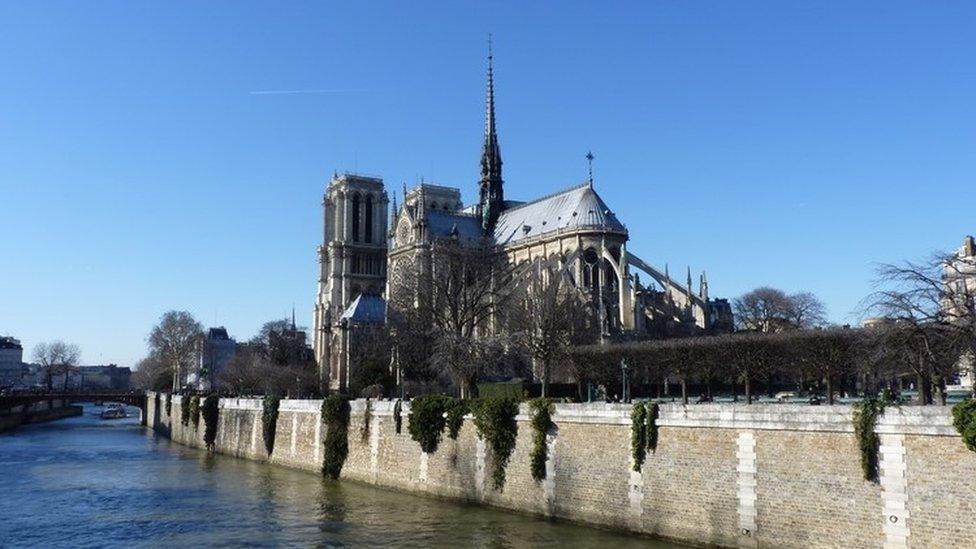
- Published15 April 2019

- Published15 April 2019
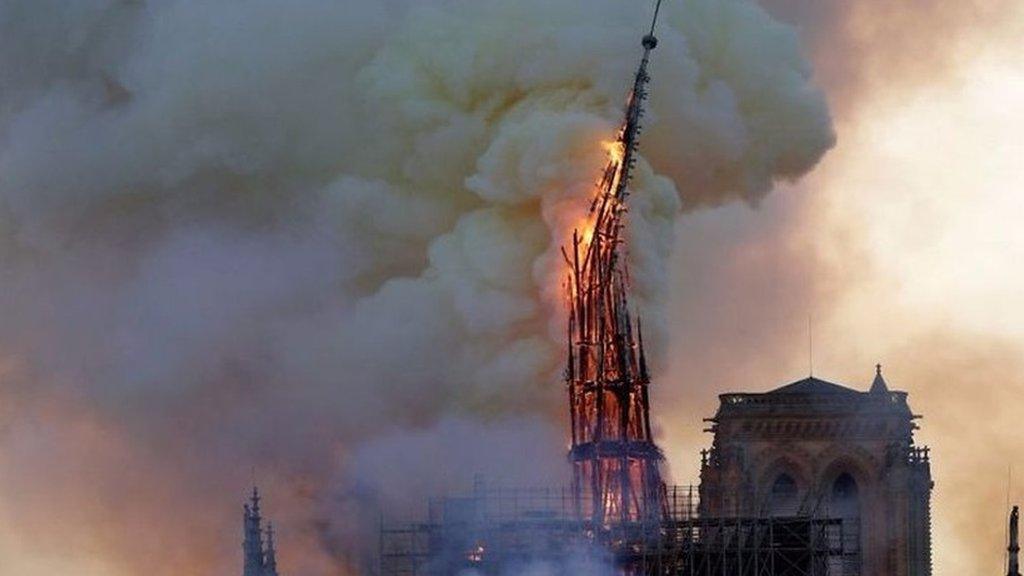
- Published16 April 2019

- Published16 April 2019
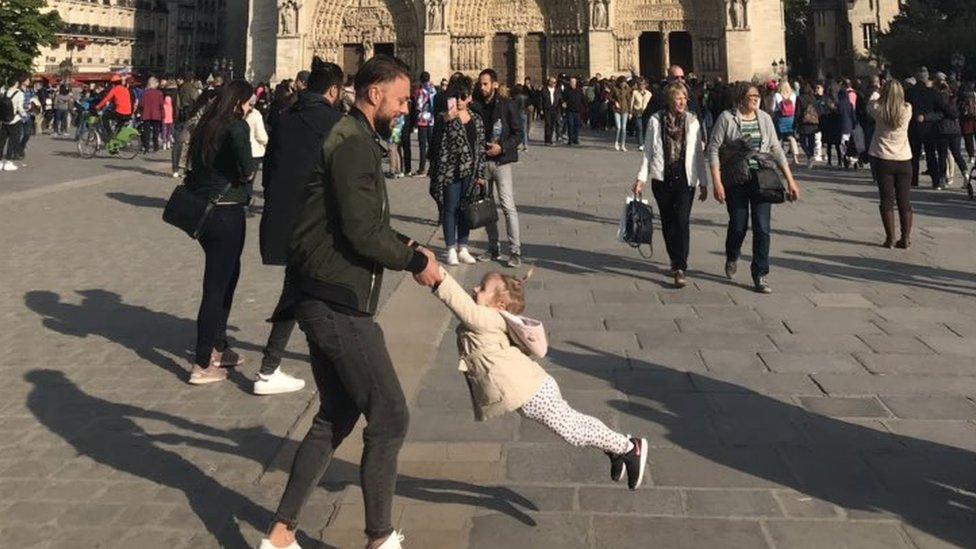
- Published5 March 2018
